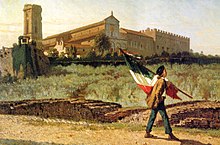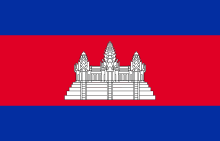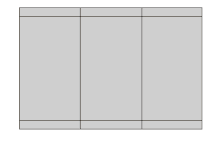National flag
| Part of a series on |
| Nationalism |
|---|
| Part of the Politics series |
| Politics |
|---|
|
|
A national flag is a
History
Historically, flags originated as
The practice of flying flags indicating the country of origin outside of the context of warfare became common with the
During the
With the emergence of
Most

In Europe, the red-white-blue tricolour design of the
The Ottoman flag (now the flag of Turkey) was adopted in 1844. Other non-European powers followed the trend in the late 19th century, the flag of Great Qing being introduced in 1862, that of Japan being introduced in 1870. Also in the 19th century, most
Currently, there are 193 national flags in the world flown by
Process of adoption
The national flag is often mentioned or described in a country's
Thus, the national flag is mentioned briefly in the Basic Law for the Federal Republic of Germany of 1949 "the federal flag is black-red-gold" (art. 22.2 Die Bundesflagge ist schwarz-rot-gold), but its proportions were regulated in a document passed by the government in the following year. The Flag of the United States is not defined in the constitution but rather in a separate Flag Resolution passed in 1777.
Minor design changes of national flags are often passed on a legislative or executive level, while substantial changes have constitutional character. The design of the
A change in national flag is often due to a change of regime, especially following a
The
Usage
There are three distinct types of national flag for use on land, and three for use at sea, though many countries use identical designs for several (and sometimes all) of these types of flag.
On land
On land, there is a distinction between civil flags (FIAV symbol ![]() ), state flags (
), state flags (![]() ), and war or military flags (
), and war or military flags (![]() ). Civil flags may be flown by anyone regardless of whether they are linked to government, whereas state flags are those used officially by government agencies. War flags (also called military flags) are used by military organizations such as Armies, Marine Corps, or Air Forces.
). Civil flags may be flown by anyone regardless of whether they are linked to government, whereas state flags are those used officially by government agencies. War flags (also called military flags) are used by military organizations such as Armies, Marine Corps, or Air Forces.
In practice, many countries (such as the United States and the United Kingdom) have identical flags for these three purposes; national flag is sometimes used as a vexillological term to refer to such a three-purpose flag (![]() ). In a number of countries, however, and notably those in Latin America, there is a distinct difference between civil and state flags. In most cases, the civil flag is a simplified version of the state flag, with the difference often being the presence of a coat of arms on the state flag that is absent from the civil flag.
). In a number of countries, however, and notably those in Latin America, there is a distinct difference between civil and state flags. In most cases, the civil flag is a simplified version of the state flag, with the difference often being the presence of a coat of arms on the state flag that is absent from the civil flag.
Very few countries use a war flag that differs from the state flag.
-
Flag of Taiwan
At sea
The flag that indicates nationality on a ship is called an
In some countries, such as the
-
The naval ensign of Italy
-
Naval ensign of the Imperial Japanese Navy and the Japan Maritime Self-Defense Force
Protocol
There is a great deal of protocol involved in the proper display of national flags. A general rule is that the national flag should be flown in the position of honour, and not in an inferior position to any other flag (although some countries make an exception for royal standards). The following rules are typical of the conventions when flags are flown on land:
- When a national flag is displayed together with any other flags, it must be hoisted first and lowered last.
- When a national flag is displayed together with the national flags of other countries, all the flags should be of approximately equal size[citation needed] and must be flown at an equal height, although the national flag of the host country should be flown in the position of honour (in the centre of an odd number of flagpoles or at the far right — left from an observer's point of view — of an even number of flagpoles).
- The flags of Saudi Arabia, Iraq, Iran, Afghanistan and Lebanon are wrapped (from left to right - from right to left from the side an observer's point of view), as some of these flags carry Arabic texts.
- When a national flag is displayed together with flags other than national flags, it should be flown on a separate flagpole, either higher or in the position of honour.
- When a national flag is displayed together with any other flags on the same flagpole, it must be at the top, though separate flagpoles are preferable.
- When a national flag is displayed together with any other flag on crossed flagpoles, the national flag must be on the observer's left and its flagpole must be in front of the flagpole of the other flag.
- When a national flag is displayed together with another flag or flags in procession, the national flag must be on the marching right. If there is a row of flags, it should be in the position of honour.
- When a national flag, with some exceptions, is flown upside down it indicates distress. This however is merely tradition. It is not a recognised distress signal according to the International regulations for preventing collisions at sea. Further, a nation's flag is commonly flown inverted as a sign of protest or contempt against the country concerned. As of now, only the flag of the Philippinesrecognises the distress symbolism of the reverse flag.
Hanging a flag vertically
Most flags are hung vertically by rotating the flag pole. However, some countries have specific protocols for this purpose or even have special flags for vertical hanging; usually rotating some elements of the flag — such as the coat of arms — so that they are seen in an upright position.[9]
Examples of countries that have special protocol for vertical hanging are: Canada, Czech Republic, Greece, Israel, the Philippines, South Africa, and the United States (reverse always showing); and the United Kingdom (obverse always showing).
Examples of countries that have special designs for vertical hanging are: Austria, Cambodia (coat of arms must be rotated 90° and blue strips are narrowed), Dominica (coat of arms must be rotated and reverse always showing), Germany, Hungary, Liechtenstein (crown must be rotated 90°), Mexico, Montenegro (coat of arms must be rotated 90° to normal position), Nepal, Slovakia (coat of arms must be rotated 90° to normal position), and Saudi Arabia (shahada must be rotated 90°). A vertical banner is used instead of the horizontal flag for Malaysia.
-
Vertical variation of the flag of Cambodia.
-
Vertical variation of the flag of Dominica.
-
Vertical variation of the flag of Germany.
-
Vertical variation of the flag of Hungary.
-
Vertical variation of the flag of Italy.
-
Vertical variation of the flag of Liechtenstein.
-
Vertical variation of the flag of Montenegro.
-
Vertical variation of the flag of Nepal.
-
Vertical variation of the flag of Slovakia.
-
Vertical variation of the flag of Saudi Arabia.
-
Vertical banner variation of the flag of Malaysia.
Design

The art and practice of designing flags is known as vexillography. The design of national flags has seen a number of customs become apparent.
Most national flags are rectangular, or have a rectangular common variant, with the most notable exception being the
The obverse and reverse of all national flags are either identical or mirrored, except for the
As of 2011 all national flags consist of at least two different colours. In many cases, the different colours are presented in either horizontal or vertical bands. It is particularly common for colours to be presented in bands of three.

It is common for many flags to feature national symbols, such as coats of arms. National patterns are present in some flags. Variations in design within a national flag can be common in the flag's upper left quarter, or canton. A third of the world's 196 countries currently have national flags that include religious symbols.[10] This has led to controversy in some secular states in regard to the separation of church and state, when the national symbol is officially sanctioned by a government.[11]
Colours

The most popular colours in national flags are red, white, green, dark blue, yellow, light blue, and black.[12] The only national flag not to include the colors red, white, or blue is Jamaica's.[13] The occurrence of each colour in all the flags is listed in detail in the table below.[12] The table shows that the colours light brown, dark brown and grey only occur in very small quantities. In fact, they only occur in the symbols on flags, such as in the Spanish flag.
| Colour | Percentage of Flags | Count of flags |
|---|---|---|
| red | 76.14% | 150 |
| white | 71.57% | 141 |
| blue | 51.78% | 102 |
| yellow/gold | 45.18% | 89 |
| green | 44.67% | 88 |
| black | 30.46% | 60 |
| orange | 4.57% | 9 |
| brown | 4.06% | 8 |
| gray | 3.05% | 6 |
| purple | 1.52% | 3 |
Similarities
Although the national flag is meant to be a unique symbol for a country, many pairs of countries have highly similar flags. Examples include the flags of Monaco and Indonesia, which differ only slightly in proportion and the tint of red; the flags of the Netherlands and Luxembourg, which differ in proportion as well as in the tint of blue used; the flags of Romania and Chad, which differ only in the tint of blue, and the flags of Cuba and Puerto Rico, which differ only in proportion, placement and tint of colors.
The flags of Ireland and Ivory Coast and the flags of Mali and Guinea are (aside from shade or ratio differences) vertically mirrored versions from each other. This means that the reverse of one flag matches the obverse of the other. Unlike horizontally mirrored flags (like Poland and Indonesia) the direction in which these flags fly is crucial to identify them.

There are three colour combinations that are used on several flags in certain regions. Blue, white, and red is a

Due to the common arrangement of the same colours, at first sight, it seems that the only difference between the Italian and the Mexican flag is only the coat of arms of Mexico present in the latter; in reality the Italian tricolour uses lighter shades of green and red, and has different proportions than the Mexican flag—those of the Italian flag are equal to 2:3, while the proportions of the Mexican flag are 4:7.[14] The similarity between the two flags posed a serious problem in maritime transport, given that originally the Mexican mercantile flag was devoid of arms and therefore was consequently identical to the Italian Republican tricolour of 1946; to obviate the inconvenience, at the request of the International Maritime Organization, both Italy and Mexico adopted naval flags with different crests.[15]
Many other similarities may be found among current national flags, particularly if inversions of colour schemes are considered, e.g., compare the flag of Senegal to that of Cameroon and Indonesia to Poland and Monaco. Also the flag of Italy and the flag of Hungary use the same colours, although the order and direction differ (the Italian flag is vertical green-white-red and the Hungarian flag is horizontal red-white-green). The same goes for the flag of France and the flag of the Netherlands (the French flag is vertical blue-white-red and the Dutch flag is horizontal red-white-blue).
Flag families
While some similarities are coincidental, others are rooted in shared histories, known as a flag family. For example, the flags of
-
Slavic countries flag family.
-
Former Federal Republic of Central America countries flags family.
See also
- Lists of flags
- Lists of flags
- Gallery of sovereign state flags
- Gallery of flags of dependent territories
- Timeline of national flags
- List of flags by colour combination
- Other
- Flag Day
- Flag desecration
- Flags of the World
- Flag protocol
- Glossary of vexillology
- National coat of arms
- National emblem
- State flag
- City flag
References
- ^ "Europe: Netherlands — The World Factbook". CIA. Archived from the original on 30 July 2021. Retrieved 28 January 2019.
- ^ Worthington, Daryl (17 October 2016). "Why Are So Many Flags Red, White and Blue?". New Historian. Archived from the original on 29 January 2019. Retrieved 28 January 2019.
- ^ "flag of the United Kingdom". Encyclopedia Britannica. Archived from the original on 2021-11-08. Retrieved 2021-11-08.
- ^ "flag of the United Kingdom". Britannica. Archived from the original on 20 December 2021. Retrieved 1 January 2022.
- ^ "Flags" in German, French and Italian in the online Historical Dictionary of Switzerland.
- ^ "The French flag". Archived from the original on 2008-04-21.
- ^ Dannebrog (in Danish). Den Store Danske. 2014. Archived from the original on 2014-07-14. Retrieved 2014-06-13.
- ^ "flag - National flags". Britannica. Archived from the original on 1 January 2022. Retrieved 1 January 2022.
- ^ Nelson, Phil (2005-12-31), Hanging Flags Vertically, Flags of the World, archived from the original on 2010-12-17, retrieved 2011-02-20.
- ^ a b Theodorou, Angelina E. "64 countries have religious symbols on their national flags". Pew Research Center. Retrieved 2024-04-03.
- ^ "64 countries have religious symbols on their national flags".
- ^ .
- ^ "What Do the Colors and Symbols of the Flag of Jamaica Mean?". World Atlas. Archived from the original on 17 July 2020. Retrieved 17 July 2020.
- ^ "Bandiera Messico" (in Italian). Archived from the original on 18 January 2016. Retrieved 17 February 2016.
- ^ "La bandiera Italiana" (in Italian). Archived from the original on 3 March 2016. Retrieved 17 February 2016.
External links
- Flags of the World, a massive online vexillological database on national and many other kinds of flags
- The World All Countries Flags, a website about national symbols
- World Flag Database reverse search for ID by colour and layout
- [1] for flag construction diagrams, flags of subnational entities, historical flags and country subdivisions
- Extensive list of similar flags from around the world























